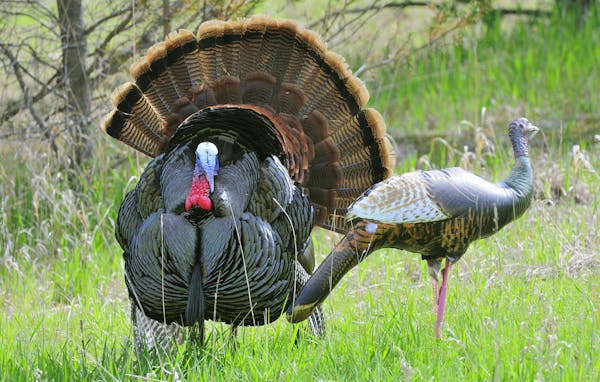Minnesota's wild turkey hunters mostly just want to see or hear a turkey during their hunts, but more than half say killing a tom is important, too, according to a new survey of state hunters.
The scientific survey, the most comprehensive ever done of Minnesota turkey hunters, also indicates 80 percent of hunters are generally satisfied with their turkey hunting experience, though less than half were happy with their turkey harvest last year. That's perhaps not surprising, considering only 39 percent of those surveyed bagged a bird in 2014.
Hunters also are largely content with the current season structure, though 60 percent favored allowing unsuccessful turkey hunters to buy a second license during a later time period. But they strongly opposed allowing a successful turkey hunter to buy a second license.
Results from the random survey of 1,400 turkey hunters age 18 and older conducted last year by the University of Minnesota will be used by the Department of Natural Resources to consider changes to the hunting season. The season structure — with eight time periods and 12 permit areas — offers a limited number of early-season licenses in a lottery drawing. The season has been generally unchanged for years, since modern turkey hunting began here in 1978.
"We've been very conservative from the start," said Steve Merchant, DNR wildlife program manager. "Turkeys historically were very limited in geography and numbers. We just don't have that situation now." Turkey numbers have increased and gobblers are now found throughout two-thirds of the state.
"It's good to take a fresh look at the whole thing," Merchant said.
The DNR plans to form a citizen advisory group to decide whether to recommend hunting season changes. Respondents were asked about several options, including eliminating the different time periods and going to a single 45-day season (42 percent support, 45 percent oppose), eliminating the 12 different permit areas and allowing open hunting throughout the state (36 percent support, 44 percent oppose), or various combinations.
The current system is designed to distribute hunting pressure.
The survey, which cost the DNR about $20,000, was done by the Minnesota Cooperative Fish and Wildlife Research Unit at the University of Minnesota's Department of Fisheries, Wildlife and Conservation Biology. The random survey and sample size reflect the views of the state's 48,000 adult turkey hunters, officials said.
But besides helping decide future management strategies, the survey also offers a fascinating picture of the state's turkey hunters and their views. Among the findings:
• Average hunter age is 52 years — which is biased high because youths weren't included. Nearly 62 percent were age 50 or older. Their average household income is about $92,000.
• State hunters have chased turkeys an average 13.5 years: 89 percent are male, 11 percent are female. They hunted turkeys last year an average three days.
• About 19 percent are members of the National Wild Turkey Federation and 29 percent belong to a local sportsmen's club.
• Turkey hunters also seek other game: 92 percent hunt deer, 54 percent hunt pheasants, 48 percent hunt grouse, 46 percent hunt waterfowl and about one-third hunt small game or predators.
• Seventy-eight percent hunt exclusively on private land, and most didn't have trouble finding a place to hunt.
• Two-thirds are satisfied with turkey regulations.
• Forty-eight percent favor and 28 percent oppose allowing hunters to buy both a regular and archery turkey license.
• Fifty-eight percent said the turkey population in the area they most hunt is satisfactory, while 37 percent consider it too low.
• Sixty percent say turkey hunting is very important to them.
• Seventy-four percent say turkey hunting is one of the most enjoyable things they do.
• "Getting food for my family" isn't a motivation for 54 percent; it is for about 32 percent.
• Enjoying nature and the outdoors is motivation for 93 percent of turkey hunters.
• Sixty percent say the DNR does a good job of managing wild turkeys in Minnesota; 7 percent disagree and 33 percent are neutral.
• Fifty-five percent agree the DNR can be trusted to make decisions about turkey management that are good for the resource; 13 percent disagree and 33 percent are neutral.
• Forty-five percent believe the DNR listens to turkey hunters' concerns; 12 percent disagree and 44 percent are neutral.
Doug Smith • doug.smith@startribune.com
Anze Kopitar scores in overtime, Kings beat Oilers 5-4 in Game 2 to tie series
Thunder's Holmgren bests Pelicans' Valanciunas in center matchup to help OKC take 2-0 lead
AP PHOTOS: Russian kids ride sticks with a horse's head in hobby horsing competition
Defending champion Golden Knights beat Stars 3-1 to take 2-0 series lead home to Vegas

